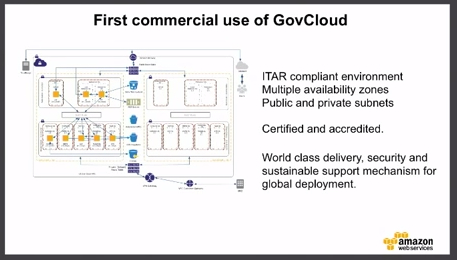GE Bets On Cloud To Transform Manufacturing

The central theme of the most recent AWS Summit was how different industries are transforming the way they do business with cloud computing. During the keynote address of Werner Vogels, Amazon CTO, a number of Amazon Web Services customers were invited to share their experiences running and building applications in the AWS Cloud.
To speak about the role that cloud computing plays in support of manufacturing, an increasingly collaborative and global enterprise, Vogels welcomed GE's Joseph Salvo to the stage.
Manager of the Business Integration Technologies Lab at GE Global Research, Salvo envisions that one day soon the industrial assets of the world, things that GE makes – like locomotives, power turbines, wind turbines, and health care equipment – will be connected into machine-to-machine networks with artificial intelligence. Ultimately, he says, these networks will have trillions of both digital and physical objects embedded within them.
"We see this new dynamic network, built out of people and intelligent machines," states Salvo. "There will be distributed devices, software and minds all working together to create innovation, but it is being limited by the speed and the ability to design, test and manufacture these increasingly complex physical systems."
These new platforms are necessary because the development time and cost associated with traditional IT methods is not sustainable, in Salvo's opinion. "But what if it were possible to speed up this whole process five-fold?" he asks. "What if we could cloud-enable this whole design-to-manufacturing process? What if we could transform the whole manufacturing paradigm from ideas to materials integration all the way to existing and novel manufacturing modalities like additive manufacturing?"
As part of its efforts to move to smarter manufacturing, GE has come up with a platform called the Crowd-driven Ecosystem for Evolutionary Design (CEED), which connects data, design tools, and simulations in one distributed, global environment. According to Salvo, the CEED platform creates a global service marketplace that enables individual users to orchestrate their own workflows then allows this pervasive collaboration environment to spontaneously assemble and disperse as the objects are created.
GE developed CEED two years ago as part of a joint project with the Defense Advanced Research Projects Agency (DARPA) and the Massachusetts Institute of Technology (MIT). CEED was designed as a crowdsourcing platform that would enable a global community to rapidly manufacture complex systems such as military vehicles, aviation systems, and advanced medical devices.
Notably, GE was the first commercial user of Amazon Web Services' GovCloud, which is the distinct datacenter with extra levels of security that Amazon operates in its Western region for government agencies. The project is a prime example of how industry can use a collaborative cloud environment to manage product design and development.
GE and its partners selected GovCloud because of several key traits:
- ITAR-compliant environment with multiple availability zones.
- Certified and accredited.
- World-class delivery and security capability.
- A support mechanism for global deployment.
Regarding this last bullet point, Salvo notes that GovCloud is collaborative but also federated. This is important because a lot of people who have intellectual property do not want to put all their information in one central location. "This system allows us to take advantage of the cloud but also distributes a lot of the models, the tools, and the data in various places all around the world, while maintaining the governance, the controllership and ownership, which is obviously very important to people in the business world," states Salvo.
He continues: "When you put this all together, you get a very flexible, elastic environment running on EC2. It allows for both rapid prototyping and simulation and building real parts that are going to be put together in some very complicated, complex systems."
"When we look at this, we think this technology holds the promise to really change the way manufacturing is architected, transform the way we create these very complex physical and software systems."
Related
With over a decade’s experience covering the HPC space, Tiffany Trader is one of the preeminent voices reporting on advanced scale computing today.











